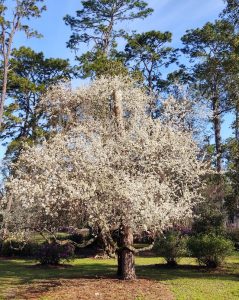Having A Variety of Flowering Plants Increases Pollinators in Your Garden
The spring-like temperatures bring us hope and excitement of new planting opportunities. Wandering around my yard yesterday, I saw bees buzzing around my azaleas, camellias and red salvias. The pollinators were working hard since there is a variety of flowers for them to choose from. What happens to those pollinators when there aren’t as many flowers as possible for them to visit? They leave in search of pollen and nectar, or their populations decrease.
Pollinators and why we need them
Many of our food crops are dependent on pollinators so it is beneficial to keep their populations thriving. We have over 300 native bee species as well as beetles, butterflies and other insects that provide pollination services. This means we need to add flowers that vary in size, shape and color to attract a variety of pollinators. As you visit garden centers and nurseries this spring, consider adding a new kind of plant or two to increase plant diversity which in turn may increase pollinators. Focus on plants that produce flowers over several months and bloom at different times of the year. To get started, check out this condensed list of plant selection options.
Plant selections by month:
January: Camellias, Petunias, Pansies, Taiwan Cherry tree, Wild White Indigo, Atamasco Lily, Bush Daisy

February: Carolina Jessamine, Loropetalum, Red Buckeye, Chikasaw Plum, Walter’s Viburnum
March: Columbine, Native Azaleas, Bridal’s Wreath, Lupines, Carolina Silverbell, Hollies, Blue-eyed Grass
April: Blue Star, Pentas, Wild Olive, Glossy Abelia, Bulbine, Chaste tree, Serrisa
May: Marigolds, Native Milkweed, Coreopsis, Phlox, Soft Greeneyes, Stoke’s Aster, Oakleaf Hydrangea
June: Purple Coneflower, Turk’s Cap Lily, Bottlebrush, Texas Sage, Blue Daze, Plumbago, Joe Pye Weed
July: Orange Coneflower, Cardinal Flower, Standing Cypress, Canna Lily, Buttonbush, Agapanthus, Mint
August: Spotted Horsemint, Giant Ironweed, Thryallis, Hydrangea, Coral Honeysuckle, Liriope
September: Firebush, Firespike, Blazing Star, Swamp Sunflower, Starry Rosinweed, Thryallis
October: Loquat tree, Spider Lilies, Mexican Sunflower, Elliot’s Lovegrass, Gaura, Muhly Grass

November: Paperplant (Fatsia japonica), Tea Olive, Purple Lovegrass, Sweet Alyssum
December: Pansies, Johnny Jump Ups, Bush Daisy, Red Salvia, Camellias, Innocence
Consider how you can help pollinators
When you get a case of spring fever, think about how you can increase pollinator habitat in your garden. You may discover new pollinators and enjoy the bright, beautiful butterflies fluttering about.
 1
1
